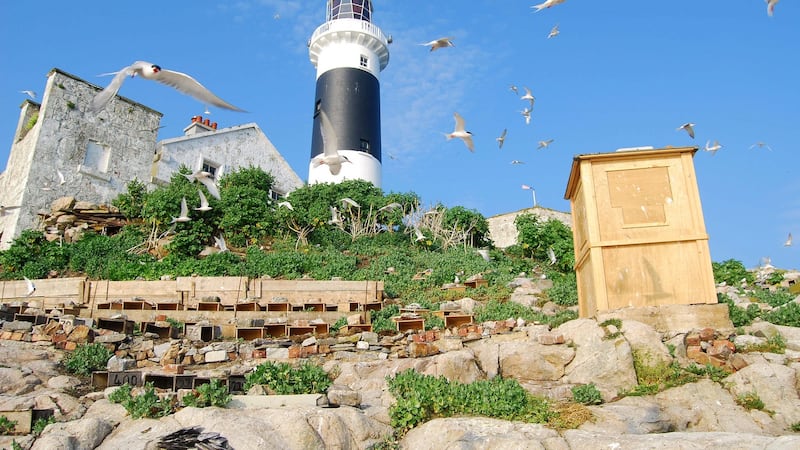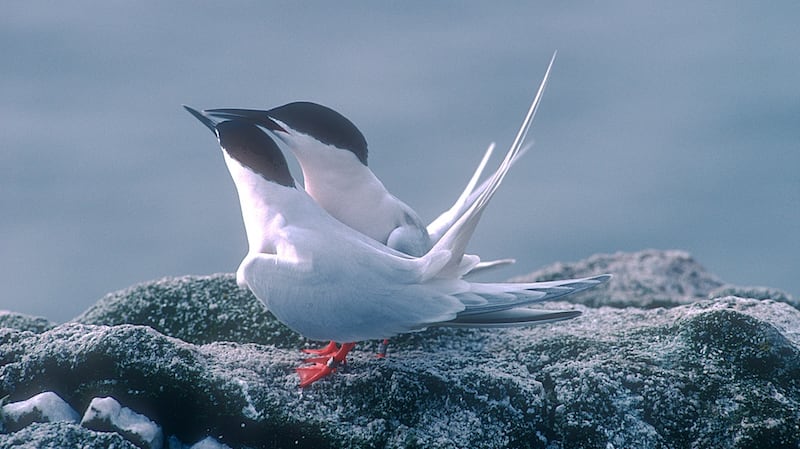A conservation success story is confirmed by touch down in Ireland this month. Roseate terns have flown in from West Africa to Europe and most are now nesting on our east coast.
Perhaps the most beautiful of all terns, the snow-white seabird sports a jet-black cap and long tail streamers. They get their name from a soft glow of shell-pink on their undercarriage. Ireland’s crucial to European roseate terns. Ninety per cent nest at Lady’s Island Lake in Wexford and on Rockabill off Dublin.
This owes to the diligent work of conservationists here. "If we took away the management their numbers would fall considerably," says ornithologist Prof David Cabot of University College Cork. "They are on life support."


It’s working. Roseate numbers fell to fewer than 500 pairs in the 1990s. Conservationists stepped in to lend them a hand. Last year, 1,556 roseate pairs were counted nesting on tiny Rockabill, 6km off the north Dublin coast. A European project (Roseate Tern LIFE) is under way to assist the birds further, with the Royal Society for Protection of Birds and the North Wales Wildlife Trust partnering Birdwatch Ireland.
As the birds began arriving in the first week of May, Birdwatch Ireland wardens were waiting to monitor, tag, and protect them from predators. A few hundred terns had nested beneath sea mallow within the walled lighthouse garden on Rockabill, but the colony has expanded beyond the wall because of new, densely-packed housing. “We now have a tiny island with about 700 to 800 nest boxes and 90 per cent of the occupied by roseate terns,” says Stephen Newton, conservationist at Birdwatch Ireland. Hundreds were on and over the island on Sunday, May 7th.
Predatory gulls, herons and owls raid tern nests, but this year EU funds will add to their protection. “We’re going to deploy devices to scare off the gulls, such as broadcasting distress calls of gulls,” says Newton, to knock out the habit of gulls hoping off boats onto the island to raid nests. The terns are safe on Rockabill from rats and mink, which can swim to islands closer to shore.
Roseate tern is the least aggressive of our five tern species and invariably nests with common or Arctic terns. Getting roseate to recolonise some of their old haunts means encouraging these other terns too, says Newton. The other Irish colony is on islands in Lady’s Island Lake, a brackish lagoon in Wexford patrolled by the National Parks & Wildlife Service. The terns there contend with more than aerial predators. “The problem is rats can swim out to the island and eat chicks and eggs, and mink too can be a problem,” says Cabot.
The roseate’s nesting habits offer them protection. The 200 roseate terns share with hundreds of common and arctic terns and over a thousand pair of sandwich terns, the largest species here. “Tern workers often wear hats for protection. Arctic terns will hit you with their legs and can peck your head,” says Cabot. Terns also nest with black-headed gulls; the gulls sometimes steal food and kill tern chicks, but in return are ferocious defenders against all nest raiders.
Protecting nest sites is essential. If disturbance by people or predators gets too much, terns will up sticks and leave. “Terns are quite a long-lived species. They have a sense that if disaster is coming, something which threatens the adult breeding bird, they will fly off and forego breeding,” say Cabot. “They won’t hang around if rats or mink arrive.”
The loss of entire colonies has history. In the 1960s, there were more 3,000 pairs nesting at over a dozen locations in Britain and Ireland. Colonies in Strangford Lough, Carlingford Lough, on Swan Island in Larne Lough, and Anglesey in Wales were abandoned, while the species disappeared from Scottish islands. The birds once nested on Connemara islands, the Blasket Islands and Copeland Islands off Co Down. Victorian hunters, the millinery trade and egg collectors all took their toll.
Conservationists are delighted with Rockabill, but they worry that all our eggs are in two baskets. “If anything happened, say an oil slick off Rockabill during the breeding season, it would be disastrous,” Cabot says. The new European project will fund protection of colonies and encourage new colonies.
Lessons learnt here are shared with the other project partners. The protections and boxes were copied on Coquet Island in the North Sea, where there are now around 100 roseate tern pairs. "Most of that colony was founded by Irish birds," says development officer for Birdwatch Ireland Niall Hatch proudly. "We are trying to encourage the guys in Scotland and Wales to create mini Rockabills."
Rockabill offers rich fishing grounds close by, where the terns catch small oily fish: sprat and sandeel. The number of chicks reared per pair though has fallen. “We don’t know if the range of these fish is changing,” says Stephen. Terns have a distinctive fishing style, pausing motionless above the sea, before diving sharply into the sea.
Cabot recently co-authored with Ian Nesbit Terns, a Collins New Naturalist book on British and Irish terns. Roseate terns are his favourites. "They are the most elegant of the terns, with really long streamers on their forked tails, which is why they were called sea swallows. They fly like bullets through the air," he says. "They've got a pinkish glow, like as if the sun was setting on their chest."
Roseate tern chicks are seeing their first sunrise from their Irish colonies this month. The first eggs were laid on Saturday, May 13th, but egg-laying started in earnest on May 18th. It’s all over by the first week of June.
PANEL: Tern spotting
This summer, Birdwatch Ireland will attach geolocator tags to roseate terns on Rockabill islands. The birds are believed to winter off West Africa, but no one knows for sure where precisely they go.
“They are beautifully adapted for flying and will take these long migrations down to West Africa every year for 10 to 20 years,” says ornithologist and tern fan David Cabot. The tags are part of an EU-funded research project. These are the last terns to migrate here in spring, generally early May. Their courtship ritual sees a pair ascend sharply in spirals before crossing and then zigzagging downwards again together. “The courtship of terns is something very beautiful,” says Cabot. “Males offer fish to females. Some fussy females won’t co-operate unless they are given food.”
Birdwatch Ireland recommends two places to see terns this summer. “We encourage people to come to Dalkey where we set up a telescope every week so people can see the common and Arctic terns there,” says Niall Hatch at Birdwatch Ireland. Late in the summer, terns from Wexford and Dublin feed around Dublin Bay and often roost on Sandymount Strand, though often far from the shoreline and late in the evening.
The second spot for tern watching is Kilcoole in Co Wicklow. "You've to walk a half a mile from the carpark down the coast but we have staff on hand to show people the little terns there. It's a sensitive area, so we have it fenced off," says Hatch. Little terns are the only Irish tern species that do not nest on offshore islands. The Wicklow colony is vulnerable to foxes and human disturbance.









